
Grape seed supplements come in many different forms and it is important to get a high quality product that has been standardized to the proanthocyanidins and contains a high enough dose to achieve a therapeutic benefit.
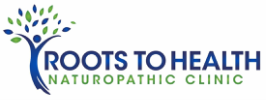
|
|
 Grape seed extract (Vitis vinifera) contains compounds known as proanthocyanidins as well as vitamin E, flavonoids and linoleic acid which act in the body as potent anti-oxidants and have many therapeutic benefits. Anti-oxidants are able to scavenge free radicals in the body that damage cells and create inflammation. Grape seed extract is often confused with Grapefruit seed extract as both may be abbreviated as GSE, but grapefruit seed is used mostly as an anti-microbial and should not be used long term. Grape seed extract on the other hand may be used long term as it can help reduce inflammation and LDL or ‘bad’ cholesterol known to be associated with atherosclerosis. Grape seed has also been shown to protect normal cells during certain chemotherapies and can be toxic to cancer cells therefore increasing the effect of the cancer treatment while reducing side effects. The anti-oxidant properties of grape seed can also help to reduce the symptoms of both asthma and seasonal allergies. Grape seed supplements come in many different forms and it is important to get a high quality product that has been standardized to the proanthocyanidins and contains a high enough dose to achieve a therapeutic benefit.
1 Comment
Lowering Blood Pressure and Cholesterol Naturally 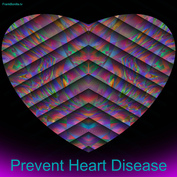 High blood pressure and high cholesterol can both lead to the development of heart disease if they are not treated appropriately. These are very common concerns in our society and there are some easy treatments that you can add into your daily life at home. 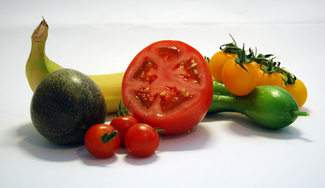 The two biggest recommendations are things that we are sure you have heard before, but we cannot stress the importance of them enough and they are eating fruits and vegetables and exercising daily. Fruits and vegetables are full of antioxidants, fiber, minerals, nutrients and so on. Exercise is needed to maintain a healthy body weight and keep the heart healthy. It has been shown that those with higher consumption of fruits and vegetables and a moderate exercise level have a significantly lower risk of heart disease. With this said we recommend trying to eat a minimum of 4 servings of fruit and 4 servings of vegetables daily. This may sound like a lot, but serving sizes are not as large as you may think. For example, a serving of fruit would be an apple or half a cup of blueberries and a serving of vegetables would be a half cup of broccoli or half of an avocado. Exercise does not have to be an intense day at the gym (unless this is something you enjoy) it can start out simply as 30 minutes of walking daily ensuring you get your heart rate up. The research has shown that you can even split this up into two 15 minute walks daily. The next treatment to add in is another simple one and that is getting at least 7-8 hours of sleep per night or what you need for your body to feel rested. This is important for blood pressure regulation as it allows the body time to relax and repair itself. 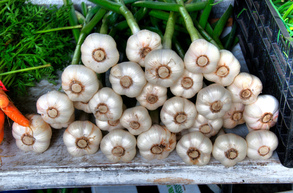 Diet can have a huge impact on heart health and an important vegetable to add in to help lower blood pressure and potentially cholesterol is celery. Celery contains chemical compounds (phthalides) which help stabilize blood vessels, therefore, allowing blood to flow more smoothly. Other dietary interventions that can help lower cholesterol are daily consumption of pomegranate juice which is also a strong antioxidant, unroasted/unsalted almonds which is also a good protein source and healthy fat source, consuming whole rolled oatmeal or oatbran for fiber and including organic soymilk for the isoflavone content. Daily consumption of raw garlic and dark chocolate, 70% or greater (typically patient’s favourite), lowers both blood pressure and cholesterol. Raw olive oil and cinnamon both help to stabilize blood glucose levels and lower cholesterol and are especially good for diabetic patients. Turmeric is also a spice that can be added in to the daily diet as it is very anti-inflammatory and can help with blood vessel stability. Consumption of fish like organic wild salmon once per week can help provide omega 3 fatty acids which are highly anti-inflammatory and helps raise good cholesterol (HDL) therefore helping to balance and normalize cholesterol levels. 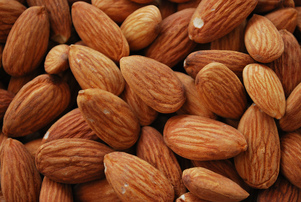 Integrating these interventions into your daily diet is simple, as you can have a salad with celery and homemade dressing with garlic and olive oil and you can even add turmeric to the dressing. Soymilk can go in cereal or can be put in oatmeal with cinnamon and almonds. Teas can be made with hibiscus, linden flower, dandelion, gingko, hawthorn and/or globe artichoke that not only help slow our day down by enjoying a cup of tea, but also help with lowering blood pressure and cholesterol. These are just a few of the diet and lifestyle interventions that can help in conjunction with Naturopathic treatments and/or with pharmaceutical medications. These can be tried before prescriptions are used and if you are interested in how much you should be consuming of these exact foods please see a Naturopathic Doctor. There are also many nutrients, minerals and botanical medicines that can be added to your individualized treatment. 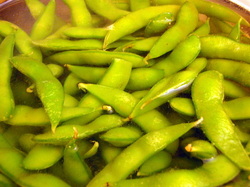 A look into the scientific research on soy. Soy has been one of the most polarizing herbs used in natural health care. Soy food is a rich source of isoflavones--a class of phytoestrogens that has both anti-estrogenic and anti-carcinogenic properties. Some believe it has great benefits for hormone balancing as well as reducing cancer and cardiovascular risks while others feel that it is a harmful plant that destroys both the earth and wreaks havoc on the human body. The answer we believe is somewhere in the middle and ultimately depends on what form of soy you are speaking about. The genetically modified (GM) version of the plant is most likely the culprit behind all of the negative exposure and ill effects that soy may cause, whereas organic, non-GM soy can have many positive effects in the body. We utilize soy a great deal in our clinical practice mostly to balance female hormones so we wanted to get to the bottom of the controversy and take a look at the scientific literature available on soy. What we found was slightly surprising in the fact that it was nearly impossible to locate any studies that showed soy to have a negative effect. The only information we came across that lead us to believe soy was harmful came from a Google search leading to various blogs and magazine articles. Searching reputable sources such as Pubmed and the Cochrane library only directed us to countless articles showing positive effects which we have briefly summarized below. As a disclaimer, we understand that clearing rainforests and fields to monocrop the GM version of the plant is harmful both to the planet and humans and we always advocate for the use of organic non GM soy. Phytoestrogens Phytoestrogens are plant sources of estrogen-like compounds and are often misunderstood to act solely as excess hormone in the body and therefore said to be harmful in conditions that are worsened by estrogen. This is misleading and does not explain how phytoestrogens work on the receptors in the human body. To quickly clarify, phytoestrogens act as weak estrogens in the body. This means that if your estrogen is too high the phytoestrogen will weakly bind to estrogen receptors and block the excess or harmful estrogen from having an effect and it will be eliminated from the body with proper liver support. On the other hand, if you have low estrogen levels the phytoestrogen will again weakly bind to the receptors and have a slight estrogenic effect to help increase the amount of estrogen in the body. Therefore, phytoestrogens are helpful in both high and low estrogen situations. Soy and Cancer The studies that have been published in this area show that soy has protective effects in cancers that are hormone related. We came across many journal articles and we have summarized a few of the meta-analyses below. Post-diagnosis Soy Food Intake and Breast Cancer Survival: A Meta-analysis of Cohort Studies. Chi F, Wu R, Zeng YC, Xing R, Liu Y, Xu ZG. Asian Pac J Cancer Prev. 2013 11 602 patients studied This meta- analysis showed that soy food intake might be associated with better survival, especially for ER negative, ER+/ PR+, and postmenopausal patients. Soy intake and risk of endocrine-related gynaecological cancer: a meta-analysis. Myung SK, Ju W, Choi HJ, Kim SC. BJOG. 2009 The results of the current study showed protective effects of soy intake on the risk for endocrine-related gynecological cancers. Association of soy and fiber consumption with the risk of endometrial cancer. Goodman MT, Wilkens LR, Hankin JH, Lyu LC, Wu AH, Kolonel LN. Am J Epidemiol. 1997 High consumption of soy products and other legumes was associated with a decreased risk of endometrial cancer. Similar reductions in risk were found for increased consumption of other sources of phytoestrogens such as whole grains, vegetables, fruits, and seaweeds. Legume, soy, tofu, and isoflavone intake and endometrial cancer risk in postmenopausal women in the multiethnic cohort study. Ollberding NJ, Lim U, Wilkens LR, Setiawan VW, Shvetsov YB, Henderson BE, Kolonel LN, Goodman MT. J Natl Cancer Inst. 2012 A reduced risk of endometrial cancer was associated with total isoflavone intake (highest vs lowest quintile, ≥7.82 vs <1.59 mg per 1000 kcal/d, RR = 0.66, 95% CI = 0.47 to 0.91), daidzein intake (highest vs lowest quintile, ≥3.54 vs <0.70 mg per 1000 kcal/d, RR = 0.64, 95% CI = 0.46 to 0.90), and genistein intake (highest vs lowest quintile, ≥3.40 vs <0.69 mg per 1000 kcal/d, RR = 0.66, 95% CI = 0.47 to 0.91). This study suggests that greater consumption of isoflavone-containing foods is associated with a reduced risk of endometrial cancer in this population of nonhysterectomized postmenopausal women. Phytoestrogen intake and endometrial cancer risk. Horn-Ross PL, John EM, Canchola AJ, Stewart SL, Lee MM. J Natl Cancer Inst. 2003 Isoflavone (OR = 0.59, 95% CI = 0.37 to 0.93 for the highest versus lowest quartile of exposure) and lignan (OR = 0.68, 95% CI = 0.44 to 1.1) consumptions were inversely related to the risk of endometrial cancer. These associations were slightly stronger in postmenopausal women. Obese postmenopausal women consuming relatively low amounts of phytoestrogens had the highest risk of endometrial cancer Adolescent and adult soy food intake and breast cancer risk: results from the Shanghai Women's Health Study. Lee SA, Shu XO, Li H, Yang G, Cai H, Wen W, Ji BT, Gao J, Gao YT, Zheng W. Am J Clin Nutr. 2009 Adult soy food consumption, measured either by soy protein or isoflavone intake, was inversely associated with the risk of premenopausal breast cancer, and the association was highly statistically significant (P for trend < 0.001). High intake of soy foods during adolescence was also associated with a reduced risk of premenopausal breast cancer (RR: 0.57; 95% CI: 0.34, 0.97). Women who consumed a high amount of soy foods consistently during adolescence and adulthood had a substantially reduced risk of breast cancer. This large, population-based, prospective cohort study provides strong evidence of a protective effect of soy food intake against premenopausal breast cancer. All of the studies show lower rates and/or recurrence of cancer in populations that consume the highest amounts of soy. These are not all of the studies done showing positive effects but we had to omit the others due to time and limited space of this blog. We were unable to locate any studies that showed negative effects of soy with cancers. From this we must conclude that benefits of soy for cancer vastly outweigh the risks. Soy and Cholesterol Soy has been shown numerous times to lower cholesterol levels and reduce the risk of cardiovascular disease. The results of a meta-analysis done in The American Journal of Clinical Nutrition in 2005 by Siyan Zhan and Suzanne C Ho titled A Meta-analysis of the effects of soy protein containing isoflavones on the lipid profile show that Soy protein containing isoflavones significantly reduced serum total cholesterol, LDL (bad) cholesterol, and triacylglycerol and significantly increased HDL (good) cholesterol. Again, studies showing negative effects of soy on cholesterol and cardiovascular health could not be found. Soy and Men Soy has been thought to increase a man’s estrogen levels and lead to female characteristics. Although a few case studies of very high dose soy consumption may have resulted in feminization, scientific evidence in humans shows that low to moderate doses of soy in the diet have beneficial effects for men as well and do not result in female features. We have summarized some of the studies below. Clinical studies show no effects of soy protein or isoflavones on reproductive hormones in men: results of a meta-analysis. Hamilton-Reeves JM, Vazquez G, Duval SJ, Phipps WR, Kurzer MS, Messina MJ. Fertil Steril. 2010 No significant effects of soy protein or isoflavone intake on T, SHBG, free T, or FAI were detected regardless of statistical model. The results of this meta-analysis suggest that neither soy foods nor isoflavone supplements alter measures of bioavailable T concentrations in men. Hormonal effects of soy in premenopausal women and men. Kurzer MS. J Nutr. 2002 Thus, studies in women have mostly been consistent with beneficial effects, although the magnitude of the effects is quite small and of uncertain significance. Only three intervention studies reported hormonal effects of soy isoflavones in men. These recent studies in men consuming soy foods or supplements containing 40--70 mg/d of soy isoflavones showed few effects on plasma hormones or semen quality. This data does not support concerns about effects on reproductive hormones and semen quality. Soybean isoflavone exposure does not have feminizing effects on men: a critical examination of the clinical evidence. Messina M. Fertil Steril. 2010 The intervention data indicate that isoflavones do not exert feminizing effects on men at intake levels equal to and even considerably higher than are typical for Asian males. Soy and Thyroid The one area where soy has been shown to have a negative effect is on the thyroid gland, specifically blocking the uptake of the synthetic thyroid hormone Synthroid. If you do not have a thyroid condition and are not taking Synthroid then soy should not negatively affect your thyroid. Conclusion After extensively searching through the scientific literature on soy we have come to the conclusion that the benefits outweigh the harms of soy and we will continue to use organic, non-GM soy as a treatment in our clinic. Any belief that soy is harmful may be based solely on theory, personal opinion, or case studies. The studies that did show little or no effect of soy were using only isoflavone isolates and not the whole bean. The research performed on soy showing positive effects is overwhelming, but as with any treatment the form and dose are critical. We always recommend consulting with your health care professional before starting any soy or supplementation routine.  One of the most common medical diagnoses today is high blood pressure or hypertension, but what does the term actually mean and what are the real risks associated with hypertension. It is true that elevated blood pressure does increase your risk of cardiovascular disease (CVD)* however the actual numbers may surprise you. The issue arises as we use terms like high, moderate and low risk in the mainstream and in medicine without specifically defining them or putting them into context. Once these risks are defined the benefits of the treatments can be described to the patient in terms of risk reduction as opposed to focusing on a decreasing the blood pressure which is a surrogate marker and has no actual meaning other than quantifying risk. Risk assessment can be done using several tools, the most popular being the Framingham Scale (2) which takes in to account cholesterol levels and calculates a 10 year risk of developing coronary heart disease (CHD)** and more recently a 5 year risk calculator for CVD from the Lancet (3) that is done without the use of cholesterol levels. It is useful to put numbers to the different classifications of risk as each person’s definition of high, moderate or low will vary greatly. Those in the ‘High Risk’ category as defined by Lancet have a 30% or greater chance of developing CVD over a 5 year period. The ‘Moderate Risk’ group using the same scale ranges from a 10-30% chance of CVD over 5 years and the ‘Low Risk’ group has a 5-10% chance of developing CVD in 5 years. The Framingham scale uses similar categories for CHD over a 10 year period creating a baseline risk using your age and modifying that risk depending on several factors listed below. According to this scale, at age 50 your risk starts at 4%, at age 60 your risk is 6% and at 70 years old your risk begins at 10% over the next 10 years. These numbers are a baseline and factors such as gender, high cholesterol levels, smoking, elevated blood pressure, family history of CVD and diabetes will increase your risk accordingly. 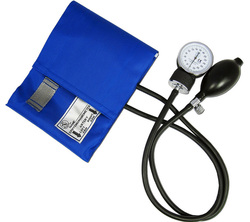 Now that we have defined the chances of developing CVD or CHD over a 5 and 10 year period, we will take a look at the effects of blood pressure lowering medications and their exact numbers in relation to decreasing the risk of all-cause mortality***. All of the following numbers are in relation to primary prevention which means that the patient has not been diagnosed with CVD or had a previous myocardial infarction also known as a heart attack. As an example to put this in to context we will look at the absolute reduction (AR) of the risk for someone who has a blood pressure starting at 160/90 mmHg before treatment and reduced to 145/85 mmHg using only one drug. The absolute risk reduction this person will receive over a 5 year period will be 1-3%. This means that if the risk started at 20% with no treatment it would be decreased to 17% after 5 years of drug therapy (Appendix A). All classes of blood pressure lowering medications have been shown to have similar absolute risk reductions of all-cause mortality (4). However, the higher your risk is to begin with the greater benefit you will see from the medication and I encourage everyone to calculate your own approximate risk of CVD and the absolute benefit you will receive from therapy. Elevated blood pressure is becoming more common as the guidelines are changed and standards lowered and it can be reduced through many interventions including diet and lifestyle changes. One example of past standards is a study published by the Lancet in 1966 which contained patients with an average blood pressure of 200/110 mmHg and the title of that study is “The Effects of Propranolol on MILD hypertension.” If that blood pressure were measured in a patient today they would be sent immediately to the emergency room. It may take time to lower your blood pressure and your readings will vary from day to day so it is best not to measure each day as this may cause stress and elevated readings for some. Two or three readings per month are enough to get an average measurement and a better overview of where your blood pressure truly stands. This article is not meant to defer people from taking their medication. We only wish to inform patients of the actual benefits of their medications. Some may find the risk reduction to be of great value and others may believe that it is not worth the trouble of taking a medication each day (which may come with some unwanted side effects). We support both opinions and encourage patients to make the final decision on their own using all of the information available. Before starting, stopping or altering any of your medications please speak to your health care professional. *Cardiovascular disease refers to any disease of the blood vessels or heart and includes stroke, heart attack, peripheral vascular disease and coronary heart disease. **Coronary heart disease refers to blockage of arteries that supply blood to the heart. ***All-cause mortality is defined as death from any cause. References 1. McCormack, J. and Allan, M. (2008) Therapeutics Education Collaboration Podcast. Episodes 3-12. 2. http://www.framinghamheartstudy.org/risk/coronary.html 3. Gaziano, T., Young, C., Fitzmaurice, G., Atwood, S. and Gaziano, J.M. (2008) Laboratory-based versus non-laboratory-based method for assessment of cardiovascular disease risk. The Lancet; 371:923 – 31. 4. The ALLHAT Officers and Coordinators for the ALLHAT Collaborative Research Group. (2002). Major Outcomes in High-Risk Hypertensive Patients Randomized to Angiotensin-Converting Enzyme Inhibitor or Calcium Channel Blocker vs. Diuretic. JAMA; 288(23):2981- 97. Appendix A
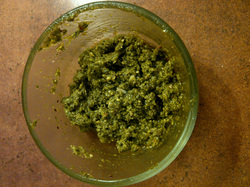 Cilantro is a great addition to many recipes but typically you only need a small amount and you end up with a lot left over and it usually goes to waste. Well this is a treat because I’ve finally found something to do with the extra cilantro. Cilantro pesto is a recipe that is cardiovascular protective because it contains nuts, garlic, olive oil and the cilantro itself is a great liver detoxifier helping balance cholesterol in the body. I thought that it would be very bold in flavour since cilantro is a stronger tasting herb, however, I was pleasantly surprised at how mild it becomes when combined with the other ingredients. Cilantro Pesto · ½ cup of raw almonds, cashews, pine nuts, walnuts, hazelnuts, flaxseeds or pecans or a combination –I use a combination of all of them except pine nuts · 1-2 cloves of garlic · 1 cup fresh cilantro leaves, washed and torn off stem, packed · 2 tablespoons fresh lemon juice · 1/3 cup unfiltered raw olive oil Put nuts in food processor, blender or magic bullet and process to make ½ cup. Add all other ingredients and process. If it gets to thick add ½-1 tbsp more of olive oil and process. Serve over brown rice pasta or on veggie burgers (see recipe). 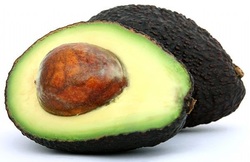 Avocados are packed with many nutrients and healthy fats which makes them an ideal part of our daily diet. Avocados are very high in fiber (14 grams per serving!) and antioxidants and contain anti-inflammatory properties. This means that they can promote cardiovascular health, blood sugar regulation, prevent chronic disease, and help with inflammatory conditions. Avocados are tasty in salads and shakes, on sandwiches, as guacamole with rice crackers or blue/red corn chips and can even be baked into muffins as a substitute for butter or oil. We've also made them into a pie - they are really versatile! Avocados are ripe when they are darker on the outside and slightly soft. It is good to leave them out on the counter in your fruit bowl as they will ripen more quickly from green to black. Once ripe the best way to cut an avocado is to cut lengthwise or vertically around the whole avocado. Be careful as there is a large pit in the middle which can then be removed. At this point you will have two halves which can be sliced or cubed right in their skin and then scooped out with a spoon. Once cut it is best to eat the avocado right away as the flesh goes brown. We have stored a half in the fridge in a tight container for one day and it is okay, but not recommended. Rubbing lemon juice on the flesh helps prevent the browning. Super Easy Guacamole · 1 avocado · 1 clove of garlic minced · 1 lemon or lime wedge · Fresh ground pepper to taste · Sliced green onions and tomatoes (optional) Cut avocado and scoop out flesh into a bowl. Mash with a fork until desired consistency. Add garlic, lemon or lime and pepper and mix. Can mix in sliced green onion and tomatoes if desired. Enjoy! Avocado “French Fries” · 2 avocados · ½ cup ground flaxseeds · 1 tbsp chili powder · ½ tsp cumin · 1/8 tsp cayenne · 1/8 tsp fresh ground pepper · Pinch of sea salt Preheat oven 350 F. Combine all ingredients except avocado into a bowl. Prepare avocados by cutting straight down longitudinally (from top to bottom) and turn avocado to slice into two halves and remove pits. Slice each of the halves into 4-5 longitudinal slices depending on how large your avocado is. Gently spoon out avocado from skin. Coat each slice singly in the spice mixture and place on a baking sheet lined with foil. Bake for 10 minutes and then turn and bake an additional 10 minutes. If you like it crunchier bake longer, if you like it softer bake for a shorter amount of time. Serve with organic ketchup. 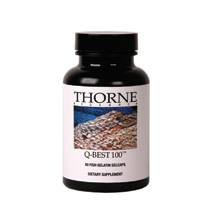 Coenzyme Q10 (CoQ10) is a cofactor required for the electron transport chain which is an energy producing process that occurs in every cell in the body. This process is especially important in the heart which needs a vast amount of energy production in order to pump blood through our bodies. The theory is that providing adequate amounts of CoQ10 should help with more efficient energy production, thus, a stronger and healthier working heart. Research has shown that people with high blood pressure, chronic heart failure and heart disease all have low amounts of CoQ10. Coq10 is also a very strong antioxidant which further benefits the conditions listed above since one thing they all have in common is the production of oxidative stress. Oxidative stress in the body can cause negative health effects and antioxidants are necessary for repair. CoQ10 also stabilizes and protects smooth muscle cells and blood vessels which could be the reason it has shown to be so effective in the treatment of high blood pressure. I believe that CoQ10 can also prevent secondary coronary events. Secondary coronary events include a second heart attack or any issue regarding the heart, occurring after a first event. If a person has never supplemented with CoQ10 and has had a coronary event then they will have an even higher demand for energy production so it would definitely be beneficial to consider adding CoQ10 into a treatment plan. It has been shown that CoQ10 is most effective when given within the first 3 days and for the first year following a coronary event in order to prevent a second one. CoQ10 is non-toxic with little to no side effects and does not typically interact with conventional medications that are given for cardiovascular issues. It is important to note that CoQ10 production in the body is blocked in people taking cholesterol lowering medications called statins (ie. Lipitor and Crestor) and every person on these medications should be taking a CoQ10 supplement. Overall, I feel that the use of CoQ10 will not harm and will most likely result in positive health benefits so should be considered in treatment plans for people with past coronary events or current cardiovascular risk. Please consult a physician before taking CoQ10 to find out whether it would benefit you and what dose would be appropriate. |
Chris and DarcieHealth tips and delicious recipes. Archives
October 2019
Categories
All
|
Book an appointment today!
|